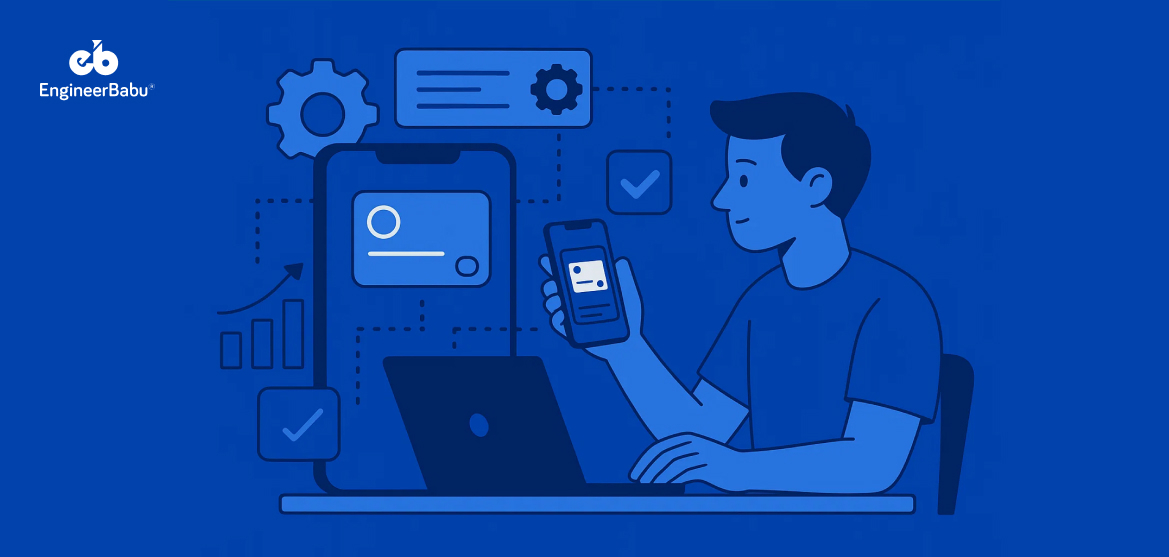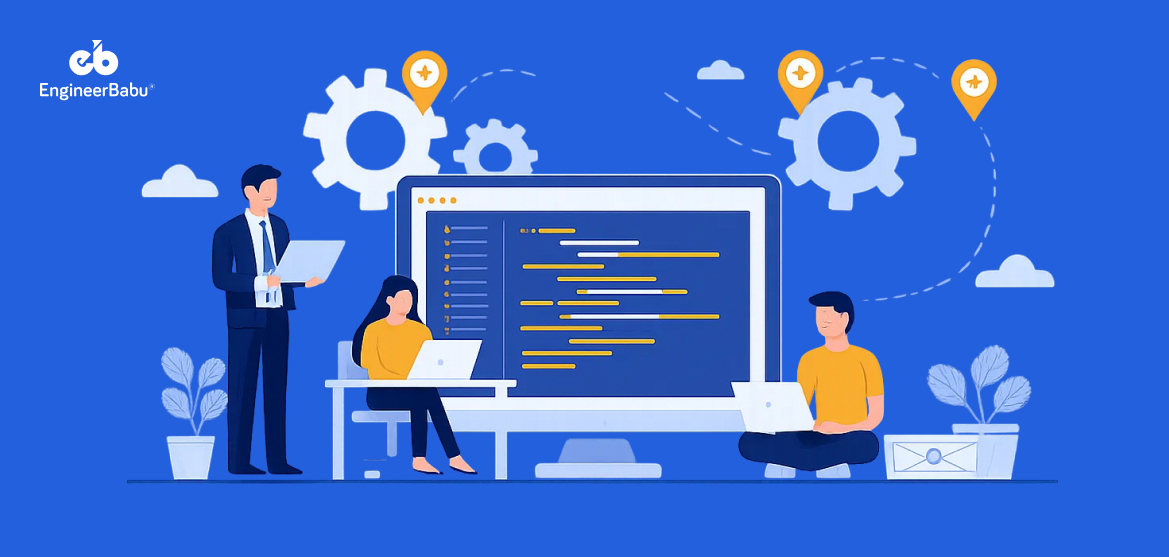Think about a bank that lives entirely in your pocket, no physical bank branches, no paperwork, just a sleek app that handles every financial task in seconds. That’s the promise of neobanks, and it’s why they’ve been redefining the way people manage money. Neobanks are transforming the banking sector by challenging traditional institutions and using advanced technology to deliver innovative financial services.
In fact, the global neobanking market was valued at $98.40 billion in 2023 and is expected to expand from $143.29 billion in 2024 to reach nearly $3.41 trillion by 2032, as per Fortune Business Insights. Within the broader financial industry, neobanks are at the forefront of digital transformation, driving disruption and reshaping how modern financial services are delivered.
To put things in perspective, Neobank app development is now the strategic move for startups and financial institutions looking to offer embedded banking services. But building one is not as easy as mobile app development.
It’s about tackling regulatory frameworks, designing for trust, and leveraging technology that can handle millions of secure transactions in real time.
Therefore, in this guide, we’ll walk through the step-by-step process of neobank app development. From validating your idea to launching a fully functional, let’s learn how to create a regulation-ready neobank app that wins user trust and market share.
Introduction to Neobank App Development
Neobank app development is revolutionizing the banking industry by offering digital-first solutions that go far beyond what traditional banking services can provide. A neobank app empowers users to manage their financial operations, access real-time account information, and perform transactions—all from the convenience of their mobile device.
The development process for a neobank app involves several critical stages: from initial planning and market research, through intuitive design and robust development, to thorough testing and seamless deployment. By partnering with a reliable app development company, financial institutions can create tailored neobank apps that deliver personalized financial services and meet the evolving needs of their customers. This approach not only streamlines banking services but also positions organizations to stay competitive in a rapidly changing financial landscape.
Whether you’re a startup or an established financial institution, investing in neobank app development enables you to offer innovative, customer-centric solutions that redefine how users interact with their finances.
Understanding Digital Banking
Digital banking has transformed the way financial institutions deliver banking services, making it possible for users to access their accounts, transfer funds, and manage their finances without ever visiting a physical branch. Unlike traditional banking services, digital banking leverages mobile apps, web platforms, and other online channels to provide a seamless, always-on experience.
With digital banking, users can view their transaction history, receive personalized financial insights, and handle account management tasks from anywhere, at any time. This level of convenience and flexibility has made digital banking the preferred choice for modern consumers who expect instant access to financial operations and tailored services.
Neobank apps are at the forefront of this digital revolution, enabling users to manage multiple accounts, track spending, and receive real-time updates—all within a single, user-friendly platform. By offering features such as instant money transfers, budgeting tools, and advanced analytics, neobank apps help users take control of their financial lives and enjoy a more personalized banking experience.
What are Neobanks?
At its core, a neobank is a fully digital financial institution that operates without physical branches, offering services exclusively through mobile apps and web platforms. Unlike traditional banks that rely on legacy infrastructure, neobanks are built on modern technology stacks. Thus, this allows them to:
- Roll out key features faster,
- Personalise user experiences, and
- Integrate seamlessly with third-party services.
If we talk about neobank app development, it is more than replicating standard banking functions, it’s about reimagining them for a mobile-first world. This means instant account creation with eKYC, AI-driven expense categorisation, real-time spending analytics, and integrated payment gateways that work across borders.
It’s also about creating an ecosystem that can evolve quickly, whether that’s integrating cryptocurrency wallets or enabling the best fintech APIs.
By understanding the core difference between simply “digitising” a bank and building a neobank from scratch, businesses can address the strategic considerations and complex steps required to launch a fully operational digital bank. Identifying the target audience during market research is crucial to tailor features and USPs that meet specific customer needs and preferences, helping solutions truly stand out in a crowded fintech market.
This knowledge forms the foundation for every decision you’ll make in the development process, from feature selection to compliance strategy. A well-designed user interface, combined with strong user experience principles, is essential for driving user engagement and satisfaction.
Neobank app development is the process of building a fully digital banking platform designed primarily for mobile users, offering lower fees and highly personalised services.
It centres around critical elements such as modern core technology, seamless digital onboarding, advanced security measures, and a powerful backend infrastructure. Let’s explore each aspect in detail.
Building a Skilled Development Team
Creating a successful neobank app starts with assembling a skilled and experienced development team. A top-tier app development company brings together developers, designers, and project managers who are well-versed in the latest trends and technologies shaping digital banking.
Your development team should have deep expertise in mobile app development, cloud infrastructure, data encryption, and advanced security measures to protect sensitive customer data. Experience working with financial institutions is essential, as it ensures the team understands user expectations, regulatory compliance, and the unique challenges of the financial sector.
By choosing a development company with a proven track record in digital banking solutions, you can be confident that your neobank app will meet the highest standards of security, scalability, and user experience. This foundation is critical for building trust with your customers and achieving long-term success in the competitive digital banking landscape.
Step 1: Market Research & Compliance Planning
Before a single line of code is written, the foundation of your neobank app is set in two critical areas – understanding the market and aligning with regulatory frameworks.
Market Research helps to pinpoint underserved customer segments, identify pain points, and understand emerging user expectations. For example, Gen Z might prioritise instant transfers, while freelancers may value multi-currency support and automated invoicing.
Equally important is Compliance Planning. Neobanks operate in one of the most regulated industries in the world, meaning you need to map out licensing requirements and compliance obligations from day one. Depending on your target market, this could include:
- KYC (Know Your Customer) and AML (Anti-Money Laundering) requirements.
- PSD2 in the EU for open banking compliance.
- RBI guidelines in India for digital lending and account operations.
Adhering to financial regulations is essential for legal operation, building customer trust, and preventing fraud. In the EU, compliance with the General Data Protection Regulation (GDPR) is a key requirement to ensure robust data protection and privacy for your users.
Here’s a fintech compliance checklist that you can follow to ensure your fintech company operates within legal and regulatory boundaries.
Step 2: Defining the App’s Core Features
Successful neobank app development starts with a clear feature blueprint, focusing on the key features that define a competitive digital banking experience. Begin by identifying must-have functions such as digital onboarding with eKYC, instant money transfers, bill payments, peer-to-peer (P2P) payments, and expense tracking. These features are essential for robust financial management, enabling users to monitor, control, and optimize their finances through real-time notifications, integrated payments, and management tools.
Next, consider differentiators that set your app apart. For instance, AI-powered financial advice, multi-currency accounts, investment tools, or cryptocurrency integration can help deliver more personalized services to users. Supporting international transactions and allowing users to hold and manage multiple currencies within a single account are also important features, especially for travelers, expatriates, and those conducting international business.
Also, P2P payments, in particular, open opportunities for social transactions, group expenses, and shared wallet features, which can be expanded into a full peer-to-peer payment ecosystem.
Related: How to build a P2P payment app?
Step 3: Choosing the Right Tech Stack
The technology you choose will define your neobank app’s speed, security, and scalability. For the front end, React Native or Flutter development enables cross-platform performance without sacrificing user experience.
On the back end, Java, Go, or NodeJS development, paired with robust databases such as PostgreSQL, ensures reliable and high-speed processing. Building reliable and scalable neobank software as the foundation of your app is essential to support seamless digital banking operations and future growth.
Security layers, end-to-end encryption, biometric authentication, and tokenisation are also non-negotiable for financial transactions. Incorporating machine learning into your security stack can further enhance fraud detection, personal data protection, and scam prevention. Cloud platforms like AWS or Azure can help you scale quickly while meeting compliance requirements.
These are the best tech stacks for finance companies that can ensure that your infrastructure supports both current needs and future expansion. Remember, a carefully chosen stack not only meets compliance but also shortens development time and reduces long-term costs.
Step 4: UI/UX Design
Design is where trust is either won or lost in neobank apps. A clean, intuitive interface reassures users that their money is safe, while poor navigation can drive them away, no matter how strong your backend is.
So, prioritise minimal screens for key actions like transfers, bill payments, and peer-to-peer transactions, ensuring each flow feels effortless.
Accessibility matters too, design for all device sizes, include high-contrast modes, and follow WCAG guidelines for inclusivity. Consistent branding, micro-animations for feedback, and well-placed security cues (like padlock icons on transaction screens) build user confidence.
The goal is not aesthetics but creating a design that feels fast, trustworthy, and personalised, keeping users engaged from their first login to daily use.
Step 5: Backend Development & API Integrations
The backend is the operational core of any neobank app, handling everything from transaction processing to account management. Choosing a scalable architecture ensures your system can handle high volumes without lag.
This is where specialised API development services plays a critical role. Secure APIs connect your app to banking partners, payment gateways, credit bureaus, and third-party fintech services. Seamless integration with these services is essential for delivering a smooth user experience and optimal system performance.
Key integrations often include KYC verification, payment processing, and open banking APIs to enable real-time financial data sharing. Implementing robust middleware ensures smooth communication between systems while maintaining performance. With this foundation, you’re ready to embed strong security layers in the next stage.
Also Read: NeoBanks vs Traditional Banks
Step 6: Security Implementation
Implement robust security measures from the outset to protect users and ensure compliance in your neobank app development process. Security is the backbone and should be a priority, shaping both compliance readiness and user trust. Every transaction, login, and data exchange must be protected with multi-layered safeguards.
This includes robust security features such as end-to-end encryption, biometric authentication, tokenisation, and AI-powered fraud detection systems that can flag unusual activity in real time.
Compliance isn’t optional here as well, frameworks like GDPR, PCI DSS requirements, and region-specific banking regulations dictate how sensitive data is stored, transmitted, and accessed.
Moreover, user perception matters as much as technical safety. Visible cues like secure icons, two-factor authentication prompts, and instant transaction alerts reassure customers that their money is protected.
Step 7: Testing & Quality Assurance
Before scaling your neobank app, it’s crucial to test the minimum viable product to validate core features and gather user feedback, ensuring your business idea is on the right track.
In neobank app development, testing is where your concept meets reality. Every feature, from account creation to peer-to-peer transfers, must be verified for functionality, speed, and security under real-world conditions.
Functional testing ensures core processes work as intended, while performance testing checks stability under high transaction loads.
Security testing is equally critical, simulating cyberattacks to uncover vulnerabilities before launch. Usability testing with real users can reveal friction points that analytics alone might miss. Lastly, regression tests after each update prevent new code from breaking existing features.
By the end of this stage, your neobank app should be stable, secure, and ready for the controlled rollout that comes with deployment.
Step 8: Deployment & Launch
Launching a neobank app is more than just uploading it to the App Store or Google Play, it’s about orchestrating a smooth market entry. Begin with a controlled rollout, targeting a smaller audience segment to gather live feedback and fine-tune performance.
In the middle of this stage, neobank app development shifts from a purely technical project to a customer acquisition strategy. This means aligning marketing campaigns, onboarding support, and in-app tutorials to ensure early users feel confident navigating the platform.
Monitor analytics closely during the first weeks, track sign-up rates, transaction volumes, and support requests to identify improvement areas. A well-managed launch not only reduces risks but also sets the tone for long-term adoption, paving the way for future feature expansions.
Conclusion
In conclusion, neobank app development is revolutionizing the future of banking by enabling secure, scalable, and user-centric digital financial solutions that keep pace with evolving customer expectations and industry trends.
Building a neobank app is not just a tech project, it’s the creation of a digital-first financial ecosystem that needs to win user trust and meet strict compliance standards.
From market research and feature planning to security implementation and launch, every stage requires precision, foresight, and a customer-first mindset.
If you’re considering entering the fintech space, partnering with experts who offer comprehensive neobank app development services can accelerate your journey. At , we specialise in delivering high-performance financial solutions tailored to your market and user needs.
Whether you’re starting from scratch or expanding an existing platform, choosing a reliable neobank development company is crucial for ensuring technical excellence, security, and long-term success. Our team can help you design, develop, and launch with confidence. Let’s talk about how we can help you hire fintech developers who will bring your neobank app idea to life.
FAQs
1. Do you need a banking licence for your neobank app?
Whether you need a banking licence depends on your business model. If you plan to operate as a fully licensed neobank, you must obtain relevant licences from the regulatory authority in your target market. However, many startups partner with existing banks or licensed financial institutions to offer banking services through APIs.
2. How long does neobank app development usually take?
The timeline for neobank app development depends on complexity, features, and compliance requirements. On average, a basic version may take 6–8 months, while advanced apps with integrations and security layers can take 12 months or more.
3. What technologies are used in the neobank apps?
Common technologies in neobank app development include front-end frameworks like React Native, backend technologies like Node.js or Java, secure databases, and cloud infrastructure. API integrations with payment gateways and banking systems are also essential.
4. How much does neobank app development cost?
Costs for neobank apps vary widely based on features, design complexity, tech stack, and compliance needs. A basic app might cost less, while a full-scale solution can run into several hundred thousand dollars.
5. Why is compliance so important in neobank app development?
Compliance ensures your neobank operates legally and securely. It covers data protection laws, anti-money laundering (AML) measures, and open banking regulations, all of which protect both the business and its users from legal and security risks.




